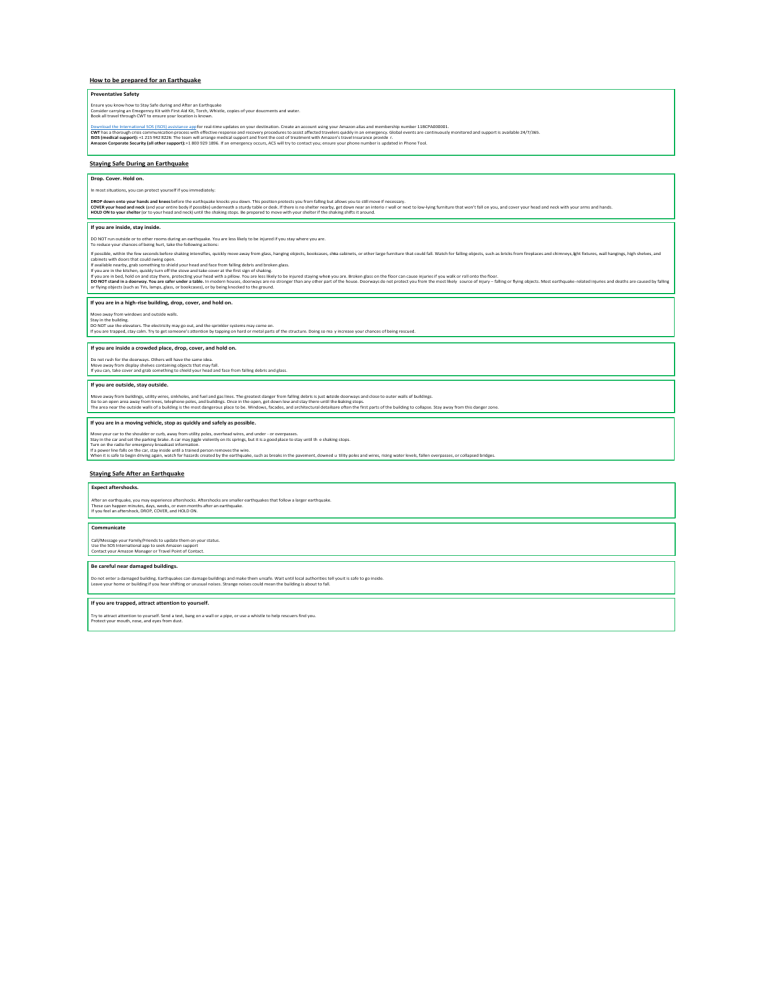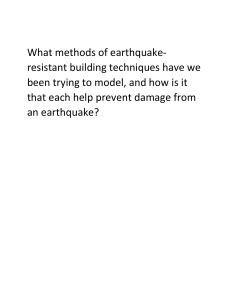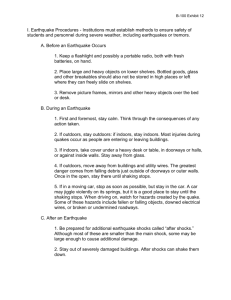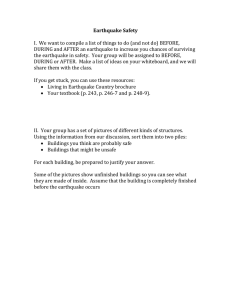
How to be prepared for an Earthquake Preventative Safety Ensure you know how to Stay Safe during and After an Earthquake Consider carrying an Emegerncy Kit with First Aid Kit, Torch, Whistle, copies of your doucments and water. Book all travel through CWT to ensure your location is known. Download the International SOS (ISOS) assistance app for real-time updates on your destination. Create an account using your Amazon alias and membership number 11BCPA000001. CWT has a thorough crisis communication process with effective response and recovery procedures to assist affected travelers quickly in an emergency. Global events are continuously monitored and support is available 24/7/365. ISOS (medical support): +1 215 942 8226: The team will arrange medical support and front the cost of treatment with Amazon’s travel insurance provide r. Amazon Corporate Security (all other support):+1 800 929 1896. If an emergency occurs, ACS will try to contact you; ensure your phone number is updated in Phone Tool. Staying Safe During an Earthquake Drop. Cover. Hold on. In most situations, you can protect yourself if you immediately: DROP down onto your hands and knees before the earthquake knocks you down. This position protects you from falling but allows you to still move if necessary. COVER your head and neck (and your entire body if possible) underneath a sturdy table or desk. If there is no shelter nearby, get down near an interio r wall or next to low-lying furniture that won’t fall on you, and cover your head and neck with your arms and hands. HOLD ON to your shelter (or to your head and neck) until the shaking stops. Be prepared to move with your shelter if the shaking shifts it around. If you are inside, stay inside. DO NOT run outside or to other rooms during an earthquake. You are less likely to be injured if you stay where you are. To reduce your chances of being hurt, take the following actions: If possible, within the few seconds before shaking intensifies, quickly move away from glass, hanging objects, bookcases, china cabinets, or other large furniture that could fall. Watch for falling objects, such as bricks from fireplaces and chimneys, ilght fixtures, wall hangings, high shelves, and cabinets with doors that could swing open. If available nearby, grab something to shield your head and face from falling debris and broken glass. If you are in the kitchen, quickly turn off the stove and take cover at the first sign of shaking. If you are in bed, hold on and stay there, protecting your head with a pillow. You are less likely to be injured staying where you are. Broken glass on the floor can cause injuries if you walk or roll onto the floor. DO NOT stand in a doorway. You are safer under a table. In modern houses, doorways are no stronger than any other part of the house. Doorways do not protect you from the most likely source of injury − falling or flying objects. Most earthquake-related injuries and deaths are caused by falling or flying objects (such as TVs, lamps, glass, or bookcases), or by being knocked to the ground. If you are in a high-rise building, drop, cover, and hold on. Move away from windows and outside walls. Stay in the building. DO NOT use the elevators. The electricity may go out, and the sprinkler systems may come on. If you are trapped, stay calm. Try to get someone’s attention by tapping on hard or metal parts of the structure. Doing so ma y increase your chances of being rescued. If you are inside a crowded place, drop, cover, and hold on. Do not rush for the doorways. Others will have the same idea. Move away from display shelves containing objects that may fall. If you can, take cover and grab something to shield your head and face from falling debris and glass. If you are outside, stay outside. Move away from buildings, utility wires, sinkholes, and fuel and gas lines. The greatest danger from falling debris is just outside doorways and close to outer walls of buildings. Go to an open area away from trees, telephone poles, and buildings. Once in the open, get down low and stay there until the shaking stops. The area near the outside walls of a building is the most dangerous place to be. Windows, facades, and architectural detailsare often the first parts of the building to collapse. Stay away from this danger zone. If you are in a moving vehicle, stop as quickly and safely as possible. Move your car to the shoulder or curb, away from utility poles, overhead wires, and under - or overpasses. Stay in the car and set the parking brake. A car may jiggle violently on its springs, but it is a good place to stay until th e shaking stops. Turn on the radio for emergency broadcast information. If a power line falls on the car, stay inside until a trained person removes the wire. When it is safe to begin driving again, watch for hazards created by the earthquake, such as breaks in the pavement, downed u tility poles and wires, rising water levels, fallen overpasses, or collapsed bridges. Staying Safe After an Earthquake Expect aftershocks. After an earthquake, you may experience aftershocks. Aftershocks are smaller earthquakes that follow a larger earthquake. These can happen minutes, days, weeks, or even months after an earthquake. If you feel an aftershock, DROP, COVER, and HOLD ON. Communicate Call/Message your Family/Friends to update them on your status. Use the SOS International app to seek Amazon support Contact your Amazon Manager or Travel Point of Contact. Be careful near damaged buildings. Do not enter a damaged building. Earthquakes can damage buildings and make them unsafe. Wait until local authorities tell youit is safe to go inside. Leave your home or building if you hear shifting or unusual noises. Strange noises could mean the building is about to fall. If you are trapped, attract attention to yourself. Try to attract attention to yourself. Send a text, bang on a wall or a pipe, or use a whistle to help rescuers find you. Protect your mouth, nose, and eyes from dust.







